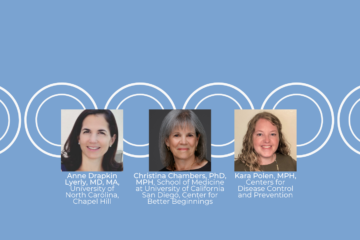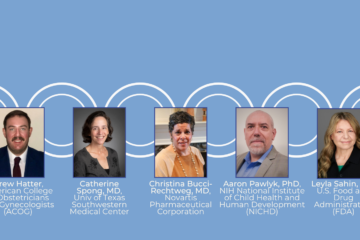During the recent national webinar and congressional briefing, “PRGLAC Then and Now: Where We Are and Where We’re Going,” the last of a three-part congressional briefing series hosted by the Coalition to Advance Maternal Therapeutics (CAMT), invited representatives from key federal agencies to discuss how they were working to advance recommendations of the Task Force on Research Specific to Pregnant Women and Lactating Women (PRGLAC), which was established as part of the 21st Century Cures Act. Specifically, the panelists, Diana Bianchi, MD, Director of the Eunice Kennedy Shriver National Institute of Child Health and Human Development (NICHD), Jennita Reefhuis, PhD, Branch Chief of the Birth Defects Monitoring and Research Branch at the U.S. Centers for Disease Control and Prevention (CDC), and Kaveeta Vasisht, MD, PharmD, Associate Commissioner for Women’s Health at the Food and Drug Administration (FDA), shared how their agencies are working toward a culture of inclusion for pregnant and lactating populations in research.
Within her remarks, Dr. Bianchi spoke about the Maternal and Pediatric PRecision In Therapeutics (MPRINT) Hub, which NICHD created as a direct result of the PRGLAC recommendations. MPRINT, described by Dr. Bianchi as a “service center and science catalyst,” consists of a Knowledge Core and Centers of Excellence and is envisioned as a national resource for expertise in maternal and pediatric therapeutics. The hub aims to address the underrepresentation of women and their infants in clinical trials. Dr. Bianchi also reviewed research being supported by NICHD, including the Azythromycin-Prevention in Labor Use Study (A-PLUS) Trial and the Commonly Used Drugs During Lactation and in Exposure (CUDDLE) Study, as well as NICHD’s efforts to enhance workforce training in areas, including inclusion and retention of pregnant and lactating persons in research (e.g., its Research Education Program grants).
Following Dr. Bianchi’s presentation, Dr. Vasisht shared information on efforts by the FDA and its Office of Women’s Health (OWH) related to the inclusion of pregnant and lactating populations in clinical trials. She began by sharing two updates from the fall of 2022 that would work toward a culture of greater inclusion. This included FDA’s issuing a proposed rule that would harmonize certain provisions of its informed consent and IRB regulations with the U.S. Department of Health and Human Services’ (HHS) Common Rule. This change, if finalized as proposed, would remove pregnant women from being categorized as a vulnerable research population. Additionally, in the fall FDA issued a final guidance for industry on enhancing the diversity of clinical trial populations. This guidance spoke to how these groups could broaden eligibility criteria and expand inclusive trial practices and trial design. It also called for the consideration of pharmacokinetic (PK) sampling to establish dosing in women who become pregnant during a trial, when possible, for their continued participation with assurances of safety. (PK sampling involves taking blood samples to determine how the body handles a given substance.)
In addition to that work, FDA has been involved in an informal working group created by the International Council for Harmonisation of Technical Requirements for Pharmaceuticals for Human Use (ICH) that was charged with thinking about a framework to enable inclusion or retention of pregnant and lactating populations in clinical trials. This work aligns with the PRGLAC Recommendation 11 to support new infrastructures and collaborations to support work in this space. Dr. Vasisht also noted research being conducted and supported by the OWH. These projects have involved looking at real world use of pharmaceuticals among pregnant and lactating women, surveys looking at health communications, addressing emerging topics, such as SARS-CoV2, and evaluating the application of machine learning.
Finally, Dr. Reefhuis spoke on CDC’s efforts to complement the clinical research activities of its colleagues. As she describes, CDC is uniquely situated to advance the health of pregnant and lactating populations in three key ways: through its use of population-based data, which supports monitoring of disease in specific geographic locations; the identification of the prevalence of use of prescription and over-the-counter medication use; and its work to ensure that pregnant women and their infants are included during public health emergencies.
These efforts are supported by Centers of Excellence, known as the Centers for Birth Defects Research and Prevention, which work on two case control studies on births from 1997 – 2011 (the National Birth Defects Prevention Study, NBDPS) and births since 2014 (Birth Defects Study to Evaluate Pregnancy exposureS, or BD-Steps). Both studies are focused on risk factors that can be changed, including medication use. She also noted the work of the Surveillance for Emerging Threats to Mothers and Babies Network (SET-NET), which funds state, local, and territorial health departments to work with CDC to identify the impact of emerging health threats, such as COVID-19, on pregnant people and their infants.
Looking ahead, the panelists agreed on the importance of implementing the remaining PRGLAC recommendations and the role that the public and federal agencies have to play in moving the needle forward:
“One thing that PRGLAC highlighted is that this is a multi-disciplinary effort, and there’s a responsibility on all of us whether you are regulatory, academia, or in the public to recognize these gaps as a critical public health matter and we all play a role.”
Dr. Kaveeta Vasisht, PRGLAC Then and Now: Where We Are and Where We’re Going (2023)
Dr. Bianchi also noted the importance of accountability in this work: “We need to be held accountable for how we’re implementing the recommendations… Continue to ask us for what we’re doing to make the recommendations viable and really contribute to changing the culture.”
To see the full conversation, view full webinar here.



0 Comments